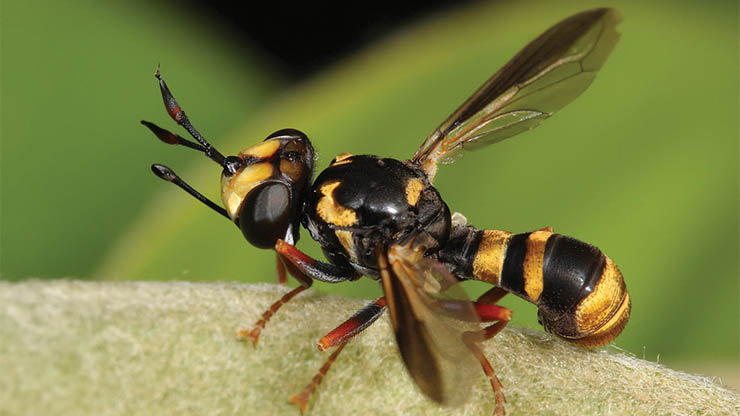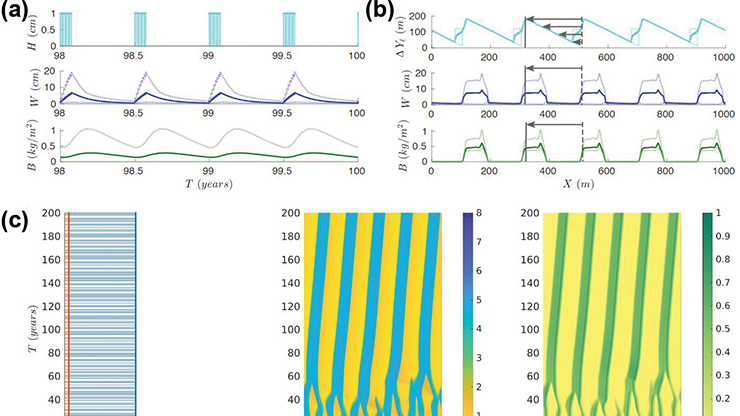Universal Equation Captures Wingbeat Frequency for Sustained Hovering
Many animal species with different evolutionary histories, such as birds and bats, are able to fly. When animals that occupy similar ecological niches face comparable selective pressures—like encounters with predators, limited food supplies, or extreme environmental conditions—they adapt to these situations and may independently develop related biological features [2]. The ability of individual species to adapt to similar circumstances in similar ways is termed convergent evolution, and flight capacity is a classic example of this fascinating phenomenon.
But how fast must a bird flap its wings to hover in the air? Physicists Jens Højgaard Jensen, Jeppe Dyre, and Tina Hecksher of Roskilde University in Denmark first posed this question to students during a graduate course to encourage math- and physics-based critical thinking. The researchers were then inspired to derive a simple mathematical equation that succinctly captures the wing flapping frequency that a flying animal must maintain to remain airborne [4].
Scientists have long attempted to quantify the rate at which a bird needs to flap its wings—called wingbeat frequency (or beats per second)—to stay aloft. This seemingly fundamental question is surprisingly complicated due to complex dynamics that involve both the biomechanics of flying animals and the physics of air.
Using the basic principles of classical mechanics, Jensen, Dyre, and Hecksher began with a simple model to capture the mathematics of a hovering animal. The upward force \(F_{\textrm{up}}\), which the wings create while the animal hovers, balances out the gravitational pull on the creature’s mass:
\[F_{\textrm{up}}=mg. \tag1\]
The wings push the air downwards to generate a balance of force and produce a lift—equal to the downward air momentum per time that comes from the wings—that allows the animal to remain airborne. The model considers the averages of upward force and the generated momentum per unit of time to account for the variation of these quantities during one wing stroke. To characterize the physical relationship in \((1)\), the researchers describe the downward momentum of air per unit of time as
\[F_{\textrm{up}}=\frac{\Delta m_{\textrm{air}}}{\Delta t}v_\textrm{air}. \tag2\]
Here, \(\Delta m_\textrm{air}\) is the mass of air that a hovering animal pushes down in one stroke, \(\Delta t\) is the time of a single stroke, and \(v_\textrm{air}\) is the average velocity.
The mass of air in motion at one instance of time is a product of the density \(\rho_\textrm{air}\) and the volume of air in motion at that time. Jensen, Dyre, and Hecksher represent volume as the product of the cross-sectional area of the downward air flow \(A_c\) and downward air velocity; they then rewrite \((2)\) as
\[F_\textrm{up}=\rho_\textrm{air}A_c v^2_\textrm{air}. \tag3\]
However, the variables of area and velocity are not easily measurable in \((3)\), which makes it difficult to solve the equation. To circumvent this issue, the trio turned to a powerful tool in physics called dimensional analysis that helps scientists analyze the relationships between different physical quantities. In fact, renowned physicists such as Niels Bohr and Lord Rayleigh have successfully employed dimensional analysis to gain astounding physical insights [3].
Jensen, Dyre, and Hecksher use this method to determine the relationship between \(F_\textrm{up}\), the area \(A\) of the wing, and wingbeat frequency. They first designate \(A_c\) as the product of wing area and a dimensionless function of all dimensionless quantities that describe wing shape. Next, they model \(v_\textrm{air}\) as the product of (i) wingspan and wingbeat frequency \((f)\) and (ii) a dimensionless function of the dimensionless quantities that define the details of wing shape and movement. The wingspan itself is the product of \(A^{1/2}\) and the dimensionless function of dimensionless quantities that describe wing shape. All of these quantities include a product with a dimensionless function to account for other kinematic quantities, such as wing-amplitude angles as well as ratios and angles that characterize wing shapes associated with wing stroke and so forth.
Incorporating these ideas and the expressions for \(A_c\) and \(v_\textrm{air}\) into \((3)\) yields
\[F_\textrm{up}=C\rho_\textrm{air}A^2f^2, \tag4\]
where \(C\) represents the proportionality constant — i.e., a combination of all unknown dimensionless functions of dimensionless quantities in the problem. By combining \((1)\) and \((4)\), the researchers create a new expression for wingbeat frequency:
\[f=\sqrt{mg/(C\rho_\textrm{air}A^2)}. \tag5\]
As an additional model assumption, the group considers \(C\) to be the same dimensionless function that encompasses all animals. Ignoring small variations in air density and gravitational strength, they can thus further simplify \((5)\) to
\[f \propto \frac{\sqrt{m}}{A}. \tag6\]
This equation represents the purest form of a proportionality relationship that describes the wingbeat frequency—solely derived from the laws of physics—of a hovering animal. Previous studies were unable to derive this formula from physical arguments alone and had to incorporate some empirical data [1].
![<strong>Figure 1.</strong> Wing/fin-beat frequency (y-axis) versus the square root of animal mass divided by the wing/fin area (x-axis). The black line depicts predicted values from the model and the colored shapes represent real data from different flying and swimming animals, ranging from insects to whales. Figure courtesy of [4].](/media/3j1gqd50/figure1.jpg)
Independent expert Tobias Wang, a professor of zoophysiology at Aarhus University in Denmark, highlighted the study as an exemplification of the value of interdisciplinary research. “It’s a very interesting paper because it’s an example of a group of physicists that use theoretical abilities and mathematical inclination to address a fundamental part of the [biomechanical] problem,” he said.
But Jensen, Dyre, and Hecksher did not stop there. Although the wingbeat frequency of birds served as their original motivation, they decided to test their equation’s applicability to other flying animals as well. “I started looking for data on birds, and there are many [works] in the literature that seemed to comply with the scaling equation that we derived,” Hecksher said. “When I presented it to my colleagues, they were intrigued and suggested that we test it on other flying animals, like insects.”
So, the trio compared their model to 414 real data points from the biological literature based on field measurements and observations of flying and swimming animals, such as insects, birds, bats, and whales [4]. Figure 1 depicts these different comparisons and proves that the model’s predicted values overlap with real data from a wide range of species.
In order to apply \((6)\) to deep-diving animals like whales and provide a recipe for fin-beat frequency, the collaborators adjusted their model to account for buoyancy and the different densities of air versus water. “You can lift your best friend in water but wouldn’t be able to do that on land,” Hecksher said. “You simply don’t weigh as much in the water because of the buoyancy.”
Even though the wings of a bat are completely different from those of a butterfly, for example, the group found a striking intersection between the predicted model values and the empirical data from different flying animals (see the black line in Figure 1). “It suggests that these different animals have more or less the same proportionality constant,” Hecksher said. This result confirms that evolution has somehow adjusted for all dimensionless quantities.
Although \((6)\) universally pertains to animals with vastly different sizes and shapes, Jensen, Dyre, and Hecksher wondered about potential limitations. They hence provide a range for which the equation holds true [4]. For instance, turbulence occurs at high Reynolds numbers that are relevant for the flying animals in the study, which means that the animals’ momentum pushes the fluid aside and viscosity is therefore negligible. But at very low Reynolds numbers—i.e., for especially small creatures—viscosity dominates and renders fluid density irrelevant. “Imagine tiny flying nanorobots or something similar,” Hecksher said. “There’s a different proportionality between the frequency of flapping and the area and mass.” The researchers depict this relationship as
\[f \propto \frac{m}{A}, \tag7\]
replacing the square root of animal mass in \((6)\) with just mass [4].
To conclude, the use of dimensional analysis provides tremendous physical insights about the biomechanics of flight and reveals striking similarities between animals that belong to different species. These results also advance our overall understanding of convergent evolution. “Evolution tends to work towards the best solution, meaning the one that can achieve the needed locomotion at the lowest possible cost,” Wang said. “Then you end up with very similar solutions.”
References
[1] Chari, N., Mukkavilli, P., & Parayitam, L. (Eds.). (2021). Biophysics of insect flight. In Springer series in biophysics (Vol. 22). Singapore: Springer.
[2] Chetan-Welsh, H., & Hendry, L. (n.d.). Convergent evolution explained with 13 examples. Natural History Museum. Retrieved from https://www.nhm.ac.uk/discover/convergent-evolution.html.
[3] Hecksher, T. (2017). Insights through dimensions. Nat. Phys., 13(10), 1026.
[4] Jensen, J.H., Dyre, J.C., & Hecksher, T. (2024). Universal wing- and fin-beat frequency scaling. PLoS One, 19(6), e0303834.
About the Author
Lakshmi Chandrasekaran
Freelance science writer
Lakshmi Chandrasekaran holds a Ph.D. in mathematical sciences from the New Jersey Institute of Technology and a master’s degree in science journalism from Northwestern University. She is a freelance science writer whose work has appeared in MIT Technology Review, Quanta, Science News, and other outlets.

Related Reading
Stay Up-to-Date with Email Alerts
Sign up for our monthly newsletter and emails about other topics of your choosing.






